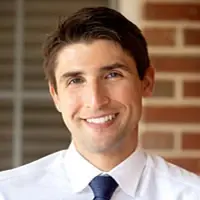I came into dentistry as a non-traditional student. I had previously spent a number of years as a healthcare economist, working for consulting firms which advised hospitals regarding their reimbursement and revenue cycle. While I was working in the healthcare field and helping hospitals serve their communities in a financially sustainable way, I found myself wanting to be more directly involved in patient care.
I considered dentistry and medicine, ultimately enrolling at the University of Illinois Chicago College of Dentistry.
Because I made the decision to become a dentist later in life, I could deliberately articulate why I chose it. It certainly wasn’t for financial reasons—I went from a good salary with bonuses and travel, living on my own in a high-rise in downtown Chicago, to taking out loans and getting a roommate in a 125-year-old apartment. For me, the tradeoff was worth it to be able to use my abilities to directly improve somebody’s life through my dental skills. Because of this, I’ve always viewed my dentistry as a gift to be shared, my license as a privilege to serve.
I started volunteering even before I knew anything about treating patients. Starting the summer before dental school, I attended block parties and health fairs to educate people about oral hygiene tips and accessing dental care. In my second year of dental school, I completed a Schweitzer Fellowship, where I partnered with a local hospital’s Excellence in Aging department to host workshop series aimed at helping seniors manage their chronic medical conditions and oral health. I helped with chairside assisting and sterilization at the Illinois Mission of Mercy. I volunteered on Saturdays as an assistant at a clinic for refugees and individuals experiencing homelessness in Chicago. While I was busy with coursework and clinical requirements in dental school, I made a point to find time to volunteer where I could.
Since beginning practice, I have been able to offer pro-bono dentistry to people near and far. I worked with the Illinois Department of Financial and Professional Regulation to accelerate my licensure application, so that I could travel to Nicaragua with a team from Global Health Outreach (GHO). Our medical/dental team in May 2021 was the first humanitarian health organization back in the country since the global COVID-19 pandemic; we were able to provide preventative, restorative, and surgical dental care to over 500 patients in a remote part of the country. I recently returned from another GHO trip to Atiquizaya, El Salvador. With the demands of owning a practice and having a young family I have not been able to attend missions like these as frequently as I would have liked, but they have been deeply meaningful and gratifying when I have been able to squeeze them in.
You don’t need to leave the country to provide volunteer dentistry, however. I’m involved in a number of local initiatives that care for the members of my community. I participate in the Dental Lifeline Network’s Donated Dental Services program; this national nonprofit pairs volunteer dentists and labs with low-income, disabled, or medically compromised patients to provide free care right from their offices. This requires basically no extra time on my part and I’m able to provide comprehensive care in my usual practice setup. Additionally, I volunteer at and serve on the Board of Managers for the Chicago Dental Society Foundation clinic, which provides free care at a clinic staffed by an experienced office manager and dental assistants.
Lastly, there are ways to volunteer aside from patient care. I feel very strongly about safeguarding the future of our profession and our patients, so I’m involved in a number of mentoring initiatives. I’m on the Advisory Council of Mentorships in Dentistry, an organization that aims to develop a diverse dental workforce through mentoring pre-dental students. I’m a mentor for dental students at my alma mater and present at career day at my high school. There are so many unique perspectives, experiences, and skills that we have to share as dentists.
Are you looking to get involved with volunteering? Here are some places you can start:
- Check with your local dental society. There may be charity dental events or opportunities in your area.
- Ask your supply partners if you can get involved with their philanthropic efforts. For example, Tokuyama Empowers cooperates with nonprofits, free clinics, national and local associations, and volunteer dentists to increase access to dental care for uninsured and underserved populations
- Sign up to volunteer with Dental Lifeline network. The registration link is https://dentallifeline.org/volunteer/
- If you live near a dental school, hygiene school, or dental assisting program, inquire about mentorship opportunities
- If you’re looking to go abroad, search for reputable organizations that regularly organize trips and have strong in-country partners. You can search for trips with Global Health Outreach at https://cmda.org/global-health-outreach/gho-find-a-trip/
Our profession has worked hard to position dentists as credible experts in our craft who serve our communities. While most of us graduate with significant debt, we earn a good living throughout our careers through the work we are paid to do. I believe it is also essential for us to do dentistry for the greater good to make optimal oral health achievable for all, and volunteering is a key piece of that puzzle.

